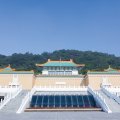NATIONAL PALACE MUSEUM
If there were only one place to visit in Taiwan, this would undoubtedly be it. Five thousand years of Chinese civilization are preserved in the art sanctuary that is the National Palace Museum. Set on a hillside, the building seems to be carved into the rock, so much so that the Taiwanese claim to have hidden their national treasures in fallout shelters dug into the mountain... And every joke has a grain of truth, since only 15,000 pieces of the 650,000-strong collection - twice the size of the Louvre - are on display. The rest are carefully guarded in galleries dug into the mountain! To appreciate the museum and its porcelain, bronzes, pottery, religious objects, clothes, paintings and cloisonné, you'll need at least a day's visit. Some of our guides speak French, so ask at reception. After the visit, the small Chih Shan park, below the main museum building (on the left), is a pleasant place to relax, and the wooden buildings that adorn it are particularly successful.
The odyssey of the palace treasures. The story of this collection is an epic one, full of twists and turns and upsets. Miraculously, some of the pieces have never been damaged, looted or lost. The gigantic collection dates back to the early Song dynasty (960-1279). Emperor Tai-Zu, a fervent supporter and lover of the arts, founded the Hanlin Academy to encourage Chinese talent. His brother, Emperor Tai-Zong, extended his elder brother's vision by adding conservation galleries to the collection, notably the Imperial Gallery, containing rare books, calligraphy and paintings. This gallery became the museum of the Northern Palace during the Song period; it was moved to Nanjing under the Ming and only returned to Peking under the Qing (1644-1911). This long dynasty was marked by emperors with a passion for art, who endeavored to centralize all the wonders of their country, especially Qianlong, who reigned from 1736 to 1795. As a result, the National Palace Museum's holdings are largely made up of imperial collections from this, China's last dynasty.
In 1924, Nationalists entered the Forbidden City and expelled Pu-Yi and his court. A team of art-historical experts was summoned to draw up an inventory of the imperial collection. It took seven years for these specialists to list all the treasures. Meanwhile, in 1925, the Nationalists founded the National Palace in Peking, in which some of the pieces were displayed. In 1931, the Japanese took over Manchuria and threatened Beijing. To prevent the collection falling into the hands of the invaders, the works of art were carefully packed into over 20,000 crates. This marked the start of a long journey: they were moved, shuffled and shaken for over fifteen years and over 12,000 km. Initially transferred to Nanjing, the collection headed west when the Japanese threatened the South. In 1935, the collection was partially shown to Westerners in London, with some fearing that the British would take advantage of the uncertain situation not to return the objects. In Europe, however, the exhibition was seen as a final tribute to the great Chinese civilization, which was under attack on all fronts and on the verge of collapse. In 1948, during the debacle before the Communists took control of the country, the collection was dismantled, and only 4,800 crates were shipped to Taiwan. They were stored in Taichung, in the center of the island, and were not shown to the public until 1965 in the relocated National Palace Museum. Some of these masterpieces, handed down over seven thousand years, were taken abroad: in 1991 and 1996, for a touring exhibition in the United States and in Paris, in 1998, to the national galleries of the Grand Palais for an exhibition entitled "Treasures of the National Palace Museum, Taipei, Memory of Empire". The collections on display rotate approximately every two or three months.
More than just an art museum, the National Palace Museum is a true guarantor of China's cultural heritage. For example, it offers expert appraisal of Chinese works of art, and works closely with the most renowned specialists in Chinese history and art, constantly adding to the collection, and providing new information about pieces on display or in reserve.
The collections. It is impossible to describe the works on display in real time, as they may have been replaced in the meantime. However, the museum makes every effort to present collections that are representative of Chinese culture in all its diversity. From Neolithic pieces (including magnificent jades and bronzes) through Tang ceramics and Song paintings, to more recent objects (notably those belonging to the emperors of the Ming and Qing dynasties). In general, the museum's 3 floors are divided into two sections, each exhibiting a particular art form. And it's easy to see why mainland China is so jealous of this unique collection... After exploring the riches of the museum, take time to relax in the Chih Shan Park below. It's an ideal place to rest and reflect on the cultural wealth you've just discovered.
Did you know? This review was written by our professional authors.
Book the Best Activities with Get Your Guide
Members' reviews on NATIONAL PALACE MUSEUM
The ratings and reviews below reflect the subjective opinions of members and not the opinion of The Little Witty.


Bon rapport qualité prix.
Une poste avec 2 employés est disponible dans le hall d'entrée , à côté de l'immense boutique du musée proposant des cadeaux souvent peu chers et de bons gouts. Incontournable !
par contre choisir son horaires car il y a plein de monde et donc du bruit .
Accès facile depuis la station de metro en bus . je l est fait a pied meme.
grande boutique et cafe mais plein.
Il y a parfois beaucoup de monde mais dans les salles on circule facilement
A ne pas rater
Magnifique et varié.